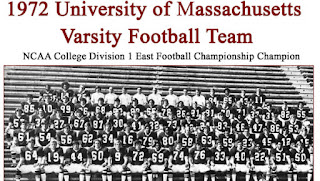It's time to journey back 50 years to the Yankee Conference of 1972, a season in which the league's six teams finished with a descending won-loss record, from 5-0 down to 0-5. This also was the last season of the YC in the original six-team alignment it had used since 1947; Boston University joined in 1973 and Vermont dropped out after the '74 campaign. (Compare that to today's successor, the CAA, where it's news if the league actually has the same teams in consecutive seasons!)
I miss the smaller, tidier Yankee Conference and often fantasize the America East Conference schools with football programs (Maine, UNH, Albany, Bryant) can form an America East football league with Rhode Island, UMass and UConn, reuniting five of the original YC members. (And let's face it: the latter two schools have no business playing in FBS, no matter how many times some Redditor defends UConn by saying, "BuT tHe FaCiLiTiEs ...")
WARNING: I may be repeating a few things from previous posts.
I've profiled a few other YC seasons: 1947, 1969, 1974, 1982, 1996.
 |
| I took this photo from this fundraising page. Hope they don't mind! |
Massachusetts, which I profiled in this post, was in the midst of a golden age, capturing its seventh title (sixth outright) in 10 years. This was the first season in which the school used the "Minutemen" nickname. (After discarding "Aggies," "Statesmen" and "Redmen" over the previous 40 years, UMass finally found a moniker that stuck.) Eight players — QB Peil Pennington, WR Steve Schubert, T Thomas Mullen, G Clarence Brooks, FB Richard Cummings, DE Ed McAleney and CB Robert Parrott — were named all-Yankee Conference. The team outscored its foes 369-155 and crushed California-Davis in the Boardwalk Bowl, 35-14, after original foe Delaware chickened out (cluck, cluck, Hens!).
UMass' uniforms didn't change from the previous season, keeping the "UM" on the helmets the Minutemen had used since '70. After a one-year helmet change in '73, UMass went to the kick-arse Minuteman helmet in '74.
The uniforms were unique in that the Huskies wore names on the back, becoming the first YC team to do so. I always liked the clever logo: A football-shaped "C" with stitches inside.
By going 3-2 in YC play, the 1972 Vermont team was the last in program history to have a winning record in league play before the school pulled the plug two years later. The Catamounts featured a strong-armed quarterback in Earl Olson, a Rutland native, who ... well, let's let his UVM Hall of Fame bio tell the rest: "In 1972 he set Yankee Conference records for yards passing (1,033 in conference games) and passes completed (84) to earn all-league honors. He ranked third in the NCAA in passing yards per game and 10th in total offense. Olson, just 5-foot-11, was twice named the team MVP (1970 and 1972)."
UVM wore a rather plain uniform, with a simple green "V" on a yellow helmet. (This would look pretty good on a helmet.) A year later, that all changed.
The coaching career of future College Football Hall of Fame coach Bill Bowes got off to a humdrum start at New Hampshire, where the Wildcats went 4-5 overall, 2-3 YC for the first of two straight seasons. (That changed greatly in 1975 and '76.) Running back Ed Whalen (no, not the Stampede Wrestling and Calgary Flames announcer) set a school record with 201 rushing yards against Springfield; his season total of 831 yards including four straight 100-yard games.
The Wildcats' uniforms were in a transition phase; at home, they still wore the older long-sleeve jerseys with the wildcat patch on the sides, but switched to a more streamlined design with shorter sleeves on the road. By 1974 both jerseys were in sync, identical to what the Cats wore in '75.
Maine went through a rough spell in the 1970s, and '72 was no exception. From what I've been able to gather, the Black Bears were the only YC team to not offer scholarships, a decision that produced a mixed reaction on campus — the pro-sports faction wanted scholarships so Maine could field more competitive teams, while the anti-sports crowd didn't want to give any free rides to the jocks. Anyway, Maine managed to win three games despite going the "pure" route.
The Black Bears changed their road uniforms in mid-season, dumping the bears-on-shoulders jerseys and red-trimmed socks for versions that's better matched what they wore at home.
 |
| Alas, I couldn't find a team photo for Rhode Island, so this group shot will have to do. |
Rhode Island, which presumably did offer scholarships, got less bang for its buck than Maine, failing to win a game in YC play. After roaring out to a 3-0 start, the Rams lost their final seven games. The 1973 Renaissance yearbook noted how young the Rams were (only eight seniors) and insisted "there seems to be hope for the future." (Rhody did leapfrog to second in the YC in '73).
The Rhody uniforms changed very little from what the Rams had worn since 1967, save for some minor changes in trim and use of sleeve numbers. A set of light blue pants debuted in 1973.





No comments:
Post a Comment